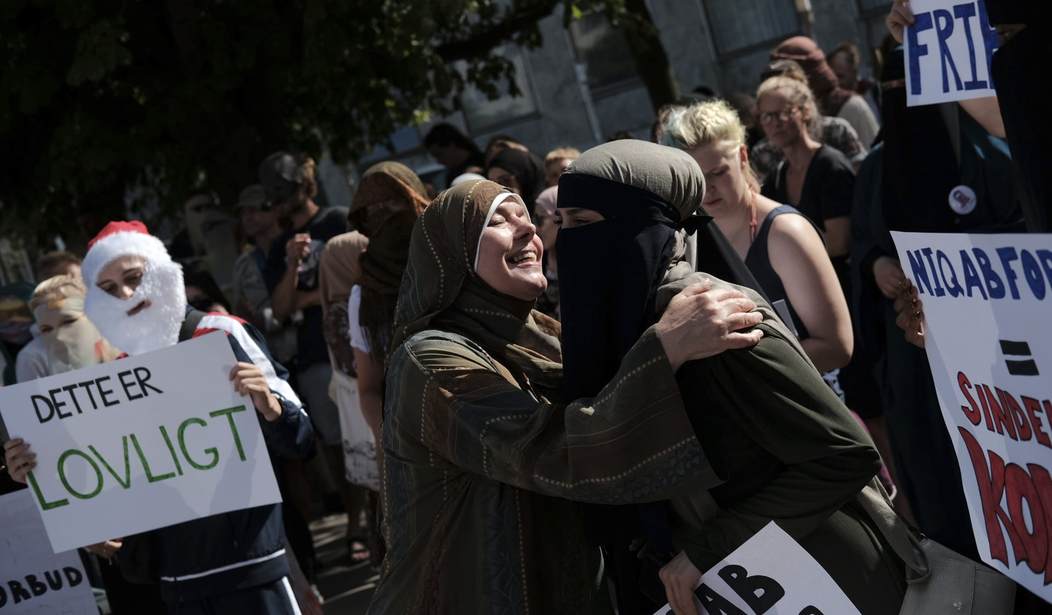On August 1, a ban on wearing face-covering attire in public took effect in Denmark, which thus joins France, Austria, and Belgium in propagating a complete prohibition on the niqab and burka. (Several other European countries forbid veils in certain locations, such as schools, hospitals, and public transport.)
The website of the Danish Broadcasting Corporation (DR) provided a thorough overview of the new law. Among its provisions: if a police officer suspects that a woman wearing niqab is being subjected to “negative social control” — i.e., living with a Stone Age father or husband — or if she says something to indicate or suggest as much, the officer may decide whether there is reason to look into the question and/or offer her help and support. Also, Danish authorities have specified that the legislation should be enforced “with due consideration to the person’s integrity.” If a woman in niqab is about to enter a mosque, the officer may choose to leave her alone. If an officer is in doubt as to how to handle any niqab-related situation that presents itself, he or she should ask a superior what to do.
Denmark’s parliament would appear to have gone to considerable trouble to try to keep from making this new dispensation more problematic than necessary. But the head of the policemen’s union, Claus Oxfeldt, is concerned that the guidelines aren’t detailed enough. He worries that if one of his officers makes a mistake, it could lead to “disaster” not only for that officer “but also for the Danish police and Denmark as a society.” This is, alas, an understandable concern: the Danes still remember how a couple of pages of Muhammad cartoons published in a newspaper a few years back led to worldwide Muslim riots, not a small number of deaths, and efforts by virtually every Islamic government on Earth to intimidate the Danish prime minister into punishing the cartoonists and editors involved and placing limits on the freedom of Danish citizens to criticize their religion.
DR didn’t just publish an overview of the new ban. It ran an article about a young woman named Ayesha Haleem. Well, at least she looks young around the eyes. In addition to her niqab, she wears black-rimmed eyeglasses that make it look as if Nana Mouskouri has converted to Islam. Otherwise it’s hard to say anything about her appearance. What we do know about her is that even though there’s now a 1000-kroner fine for walking around in public in niqab, she vows never to take hers off.
DR’s article was accompanied by a video of Ayesha and her husband walking their child in a stroller. “I will pay the fine,” Ayesha said in English, “but I will not take out my niqab.” She meant, of course, take off her niqab. She and her husband, we were told, have lived in Denmark for almost six years. Apparently she can’t speak Danish, at least not even well enough to conduct a brief, simple media interview. And her English is shaky. “It’s not fair,” she said, referring to the fine, “because we will be paying this fine from our own savings.” As opposed to what?
Ayesha explained that she considers wearing her niqab a matter of personal freedom. She’d been planning to stay in Denmark and study religion, but the ban, she fretted, might force her and family to leave Denmark. “No one wants to live in a country where you don’t have your freedom and can’t practice your religion,” said her husband, Haleem Shah — whose own religious garb, as could be observed in DR’s video, consists of sneakers, a pair of jeans, and a lilac polo shirt.
DR had even more on the topic. Reporter Emil Søndergård Ingvorsen found what he called two “polar opposites” within the Muslim community — both of whom agreed that the niqab ban violates individual freedom. One of those two persons was Oussama el-Saadi of the Grimhøj Mosque, which Ingvorsen described as “conservative.” Yes, that’s one way to put it. Two years ago, as it happens, a hidden-camera report on Denmark’s TV2 showed another imam at that mosque ordering parents to beat their children over ten years old who don’t pray to God.
The TV2 report noted that these child-rearing instructions contrasted dramatically with el-Saadi’s assertion, in a non-hidden-camera interview, that his mosque’s teachings are entirely consistent with Danish cultural norms. That was a curious claim, given that el-Saadi himself was already on the record as having urged the Danish government to recognize Islamic marriages between little girls and old men. Instead of having since been kicked out of the country, this creep is still holding forth on Danish law in the media. And guess what? Surprise! He supports the “right” of Muslim women to wear niqab.
El-Saadi’s “polar opposite” is Sherin Khankan, Denmark’s first female imam, who runs her own all-female mosque in Copenhagen. She’s liberal, divorced, has long hair, doesn’t wear any head covering, and is purportedly one of those so-called “bridge builders” that the Western media adore. According to a 2015 profile, she’s “a half-hearted revolutionary,” eager to bring Islam into the contemporary world but loath to anger her fellow believers. Her take on the niqab: “We can’t liberate women by violating some women’s rights. We have to find another way to help those women who are oppressed or forced to cover themselves.” Great! Any ideas? No, I didn’t think so.
The rest of the Danish mainstream media chimed in along much the same lines. In Politiken, for example, Henrik Marstal condemned the niqab ban on feminist grounds, arguing that “any feminist-minded politician would have respected the free choice of attire.” Sorry, but I don’t care about the view of the Western feminist establishment, which has been entirely AWOL on Islam’s abuse of women. Meanwhile, in the same newspaper, Saer el-Jaichi, a PhD in Islamic Studies, decried the niqab ban as the product of Denmark’s “collective hysteria in relation to Muslims and Islam.” Yes, “hysteria.” Can’t imagine what has caused it.
Anyway, on August 1, about 1300 protesters gathered in Nørrebro, an increasingly Muslim neighborhood in Copenhagen, to bash the ban. Most of them deliberately violated it. What did the police do? Nothing. Two days later, however, the first arrest under the law was made at a shopping mall in Hørsholm, north of Copenhagen. Two women, one of them in a niqab, got into a scuffle on an escalator. “During the fight, her niqab fell off,” said one of the arresting officers, “but by the time we arrived, she had put it back on.”









Join the conversation as a VIP Member